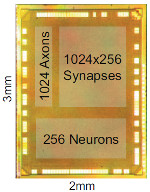IBM has simulated a neurocomputer comparable to the human brain
At the Supercomputing 2012 conference, IBM presented the results of the Compass neuro simulator on the Sequoia supercomputer (second place in the world ranking of supercomputers). For the first time, a scale corresponding to the human brain was achieved - 530 billion neurons and 137 trillion synapses. The simulation occurred 1542 times slower than real time. It involved all 1,572,864 cores and a half petabytes of memory.
 Compass is a simulation system for the new TrueNorth computer architecture, which IBM calls Watson's Big Brother. Unlike our familiar computers based on von Neumann architecture, TrueNorth is built in the image of the brain, based on IBM's " neurosemantic cores"- chips containing silicon neurons and synapses. Each chip contains 256 neurons, 1024 axons and 256x1024 synapses. The area of the chip produced by 45-nanometer technology is 4.5 mm 2. In a record simulation, the work of 2084 billion such nuclei was simulated.
Compass is a simulation system for the new TrueNorth computer architecture, which IBM calls Watson's Big Brother. Unlike our familiar computers based on von Neumann architecture, TrueNorth is built in the image of the brain, based on IBM's " neurosemantic cores"- chips containing silicon neurons and synapses. Each chip contains 256 neurons, 1024 axons and 256x1024 synapses. The area of the chip produced by 45-nanometer technology is 4.5 mm 2. In a record simulation, the work of 2084 billion such nuclei was simulated.
This work was done in the framework of the DARPA SyNAPSE , whose ultimate objective - to create neurocomputer comparable with the brain of higher mammals, both in speed and cognitive abilities, and for the compactness and energy consumption it is, in fact we are talking about the creation of the brain to "terminat. . moat "Here are some of its features:
IBM has been working on a “cognitive computer” for DARPA for several years. So, in 2009, the results of neurosimulation on the scale of the brain of a cat were presented . It is too early to talk about a realistic imitation of the human brain, because in addition to a sufficient number of neurons, you still need to know the scheme of their connection and, most importantly, the program that controls the brain. There is also progress in this direction. One of the simulations in the framework of DARPA SyNAPSE was based on the connection scheme of neural complexes in the macaque brain, obtained in the framework of the CoCoMac project .
 Compass is a simulation system for the new TrueNorth computer architecture, which IBM calls Watson's Big Brother. Unlike our familiar computers based on von Neumann architecture, TrueNorth is built in the image of the brain, based on IBM's " neurosemantic cores"- chips containing silicon neurons and synapses. Each chip contains 256 neurons, 1024 axons and 256x1024 synapses. The area of the chip produced by 45-nanometer technology is 4.5 mm 2. In a record simulation, the work of 2084 billion such nuclei was simulated.
Compass is a simulation system for the new TrueNorth computer architecture, which IBM calls Watson's Big Brother. Unlike our familiar computers based on von Neumann architecture, TrueNorth is built in the image of the brain, based on IBM's " neurosemantic cores"- chips containing silicon neurons and synapses. Each chip contains 256 neurons, 1024 axons and 256x1024 synapses. The area of the chip produced by 45-nanometer technology is 4.5 mm 2. In a record simulation, the work of 2084 billion such nuclei was simulated. This work was done in the framework of the DARPA SyNAPSE , whose ultimate objective - to create neurocomputer comparable with the brain of higher mammals, both in speed and cognitive abilities, and for the compactness and energy consumption it is, in fact we are talking about the creation of the brain to "terminat. . moat "Here are some of its features:
- 10 billion neurons
- 100 trillion synapses
- power consumption within 1 kW
- occupied volume - less than 2 dm 3
- interfaces for sensory perception and motor functions
IBM has been working on a “cognitive computer” for DARPA for several years. So, in 2009, the results of neurosimulation on the scale of the brain of a cat were presented . It is too early to talk about a realistic imitation of the human brain, because in addition to a sufficient number of neurons, you still need to know the scheme of their connection and, most importantly, the program that controls the brain. There is also progress in this direction. One of the simulations in the framework of DARPA SyNAPSE was based on the connection scheme of neural complexes in the macaque brain, obtained in the framework of the CoCoMac project .
